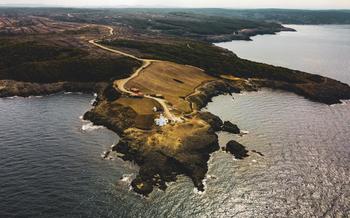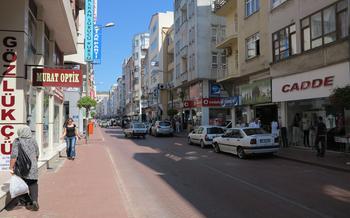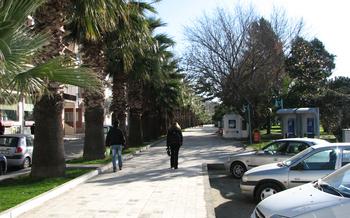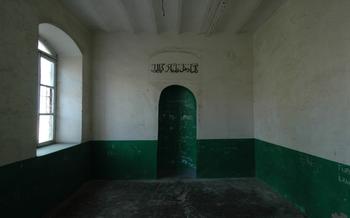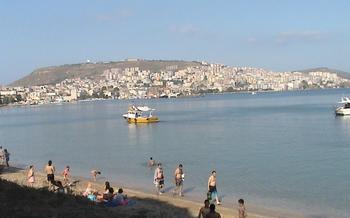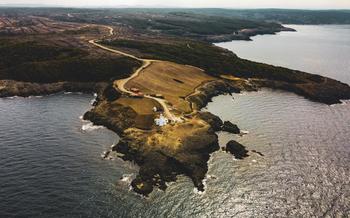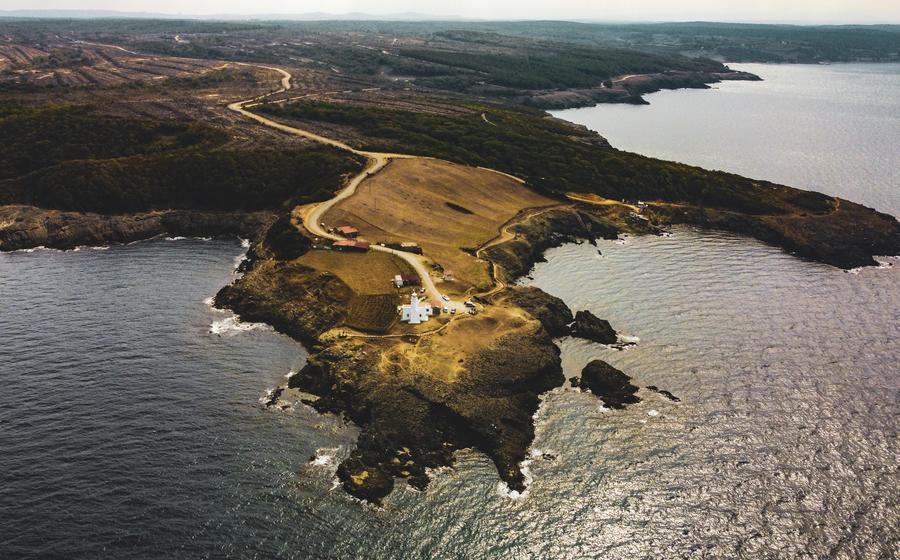
Sinop Tersanesi (Shipyard)
- History of the Sinop Tersanesi
- Exploring the Shipyard
- Maritime Museum
- Shipbuilding Traditions
- Cultural Heritage
- Location and Accessibility
- Visiting Hours and Fees
- Duration of Visit
- Photography Tips
- Souvenirs and Local Crafts:
- Nearby Attractions
- Dress Code and Etiquette
- Accessibility for Disabled Visitors:
- Insider Tip:
History of the Sinop Tersanesi
The Sinop Tersanesi, or shipyard, holds a significant place in the maritime history of Turkey. Established in the 13th century during the Seljuk era, the shipyard played a crucial role in building and maintaining naval vessels for the Ottoman Empire. Its strategic location on the Black Sea coast made it a vital center for shipbuilding and naval operations.
The shipyard's architectural features reflect the advanced shipbuilding techniques of the time. The Tersanesi comprises several dry docks, slipways, and workshops, all designed to facilitate the construction and repair of wooden ships. The shipyard's design allowed for efficient workflow and maximized productivity, contributing to its reputation as one of the most important shipyards in the region.
Over the centuries, the Sinop Tersanesi underwent several renovations and expansions. During the 16th century, under the reign of Suleiman the Magnificent, the shipyard was significantly enlarged, becoming one of the largest and most well-equipped shipyards in the Ottoman Empire. The shipyard continued to operate until the 19th century, when it gradually declined due to technological advancements and the rise of ironclad ships.
In recent years, the Sinop Tersanesi has undergone extensive restoration efforts to preserve its historical significance and architectural heritage. The shipyard has been transformed into a museum, showcasing the rich history of shipbuilding in Turkey. Visitors can now explore the shipyard's various sections, marvel at the preserved ships and artifacts, and gain insights into the traditional shipbuilding methods of the Ottoman era.
Exploring the Shipyard
The Sinop Tersanesi offers a fascinating glimpse into the rich maritime heritage of Turkey. Visitors can explore the shipyard's various sections, each dedicated to a specific aspect of shipbuilding. From the bustling workshops to the dry docks, every corner of the shipyard exudes a sense of history and craftsmanship.
The shipyard is home to a diverse collection of ships and vessels, ranging from traditional wooden sailing ships to modern steel-hulled vessels. Visitors can admire the intricate carvings and designs of the wooden ships, showcasing the skills and artistry of the master shipbuilders. The shipyard also houses a collection of model ships, providing insights into the evolution of shipbuilding techniques over the centuries.
During the Ottoman era, the shipbuilders of Sinop employed a variety of tools and techniques to construct their vessels. Visitors can learn about the traditional methods of shipbuilding, including the use of hand tools, natural materials, and ingenious engineering solutions. Guided tours and interactive exhibits provide visitors with a deeper understanding of the processes and techniques involved in shipbuilding.
Maritime Museum
The Sinop Tersanesi Maritime Museum offers a fascinating glimpse into the rich maritime heritage of Turkey, showcasing an array of exhibits that delve into the art and science of shipbuilding, navigation, and seafaring. The museum houses a diverse collection of model ships, each meticulously crafted to replicate historic vessels that once sailed the seas. These models, along with detailed maps and navigational instruments, provide visitors with an understanding of the intricate techniques and technologies used by ancient mariners. Artifacts from various periods, including anchors, cannons, and navigational tools, add to the museum's authenticity, offering a tangible connection to the region's maritime past.
Educational programs and workshops are regularly conducted at the museum, catering to visitors of all ages. These programs aim to foster a deeper appreciation for maritime history and traditions, while also providing hands-on experiences that allow visitors to engage with the exhibits in a meaningful way. Through interactive displays and guided tours, the museum brings to life the stories of the skilled shipbuilders, sailors, and explorers who shaped the maritime legacy of Turkey.
Shipbuilding Traditions
The Sinop Tersanesi offers a glimpse into the rich shipbuilding traditions of Turkey. Visitors can learn about the methods and techniques used by master shipbuilders and craftsmen during the Ottoman era. The shipyard showcases the intricate art of carving, shaping, and assembling wooden ships using traditional tools and techniques.
One of the highlights of the shipyard is the demonstration of traditional shipbuilding techniques. Visitors can observe skilled artisans using hand tools to shape and assemble wooden planks, creating the hull of a ship. The shipyard also displays a collection of traditional shipbuilding tools and equipment, providing insights into the craftsmanship and ingenuity of the shipbuilders.
The shipyard also highlights the use of local materials and sustainable practices in traditional shipbuilding. Visitors can learn about the selection and preparation of wood, as well as the use of natural materials such as tar and pitch for caulking and waterproofing the ships. The shipyard's commitment to preserving traditional shipbuilding practices makes it a valuable resource for understanding the maritime heritage of Turkey.
Cultural Heritage
The Sinop Tersanesi stands as a testament to the rich maritime heritage of Turkey. It encapsulates the nation's centuries-old tradition of shipbuilding, a craft that has played a pivotal role in shaping its naval prowess and global connections. Preserving traditional shipbuilding practices is of paramount importance, as they represent a tangible link to Turkey's past and a source of national pride.
The shipyard serves as a living museum, showcasing the ingenuity and craftsmanship of Turkish shipbuilders. It provides a unique opportunity for visitors to delve into the intricate techniques and processes involved in constructing wooden ships using locally sourced materials. By promoting cultural tourism, the shipyard contributes to the preservation and appreciation of Turkey's maritime legacy, ensuring that future generations can continue to marvel at the wonders of traditional shipbuilding.
Various initiatives are underway to safeguard and promote the shipyard's legacy. These include educational programs, workshops, and exhibitions that aim to raise awareness about the importance of preserving traditional shipbuilding practices. The shipyard also collaborates with local artisans and craftsmen to create unique souvenirs and handicrafts inspired by the shipyard's rich history. These initiatives not only support the local economy but also contribute to the preservation and transmission of traditional knowledge and skills.
Location and Accessibility
The Sinop Tersanesi is strategically located in the heart of Sinop, a charming coastal city in northern Turkey. Its exact coordinates are 40313° N, 31539° E. Reaching the shipyard is a breeze, thanks to its proximity to major transportation hubs. From Istanbul, the country's vibrant metropolis, you can hop on a scenic 12-hour bus ride or take a quick 1-hour flight to Sinop Airport (SIC). Once in Sinop, the shipyard is just a short walk or taxi ride away from the city center. Public transportation options are also available, making it easy to explore the shipyard and other nearby attractions. Ample parking facilities are provided for visitors arriving by car, ensuring a hassle-free visit.
Visiting Hours and Fees
Visiting Hours: The Sinop Tersanesi is open to visitors from 9:00 AM to 5:00 PM, seven days a week. However, it is recommended to check the official website or contact the shipyard directly for any updates or special events that may affect the operating hours.
Entrance Fees: - General Admission: 20 Turkish Lira (TL) - Students/Seniors: 10 TL - Families: 40 TL (2 adults and 2 children)
Discounts and Concessions: - Discounts are available for students, seniors, and families. - Advance booking or reservations for large groups may be eligible for special rates or guided tours.
Advance Booking and Reservations: - For groups of 10 or more, it is advisable to make a reservation in advance to ensure a smooth and organized visit. - Reservations can be made online or by contacting the shipyard directly.
Duration of Visit
Allocate at least two to three hours for a comprehensive visit to the Sinop Tersanesi, allowing ample time to explore the shipyard, discover its fascinating exhibits, and immerse yourself in the rich maritime history of Turkey. Stroll through the various sections, marveling at the intricate details of the ships and learning about the shipbuilding techniques of yesteryear. Take your time to capture stunning photographs of the shipyard's picturesque setting and soak in the ambiance of this unique historical site.
Consider combining your visit to the shipyard with other nearby attractions, such as the Sinop Fortress or the Sinop Archaeological Museum, to create a fulfilling and comprehensive itinerary. Public transportation or guided tours are readily available, making it convenient to explore multiple sites in a single day. Plan your visit during the off-season or on weekdays to avoid crowds and fully appreciate the tranquility of the shipyard.
Photography Tips
The Sinop Tersanesi offers a treasure trove of photographic opportunities, waiting for you to capture its essence. To make the most of your visit, here are a few tips to help you capture stunning images:
Golden Hours: - Arrive during the golden hours, either early morning or late afternoon, when the light is warm and diffused. This will enhance the colors and textures of the shipyard.
Wide-Angle Lens: - Use a wide-angle lens to capture the expansive views and sweeping vistas of the shipyard. It will allow you to fit more of the scene into your frame.
Details and Close-ups: - Don't forget to focus on the intricate details of the ships, tools, and architecture. Close-up shots can reveal hidden gems and showcase the craftsmanship of the shipbuilders.
Natural Backdrops: - Utilize the natural backdrop of the sea and the sky. Position ships against the horizon or incorporate the beautiful clouds into your compositions.
Reflections: - Play with reflections in the water to create dynamic and artistic shots. The reflections of the ships in the calm waters can add depth and interest to your images.
Respect and Ethics: - Be mindful of other visitors and avoid obstructing their views or disturbing their experience. Always ask for permission before photographing people.
Souvenirs and Local Crafts:
The Sinop Tersanesi offers a unique opportunity to purchase souvenirs and crafts inspired by the rich shipbuilding heritage of the region. Local artisans and shops display a variety of handmade items, including intricate models of ships, traditional tools, and decorative items crafted from wood or metal. These souvenirs serve as tangible mementos of your visit and help support the local economy.
When shopping for souvenirs, be sure to engage with the artisans and learn about their techniques and inspirations. Bargaining is acceptable and even expected in local markets; embrace this cultural practice as a way to connect with the locals and score a great deal.
Look for items made from locally sourced materials, such as olive wood or copper, to ensure authenticity and sustainability. These unique crafts not only commemorate your visit to the Sinop Tersanesi but also serve as a reminder of the region's rich maritime history and craftsmanship.
Nearby Attractions
Beyond the shipyard itself, Sinop offers a wealth of historical and cultural treasures that make it an ideal destination for a comprehensive exploration. The iconic Sinop Fortress, a 7th-century Byzantine citadel, stands as a testament to the city's rich past. Visitors can delve into the fascinating history of Sinop at the Sinop Museum, which houses an impressive collection of artifacts from various periods. For those interested in nature and wildlife, the Hamsilos Bay National Park, just a short drive from the city center, boasts stunning landscapes, pristine beaches, and a diverse array of flora and fauna. To create a well-rounded itinerary, consider combining the shipyard visit with other nearby attractions, such as the Sinop Lighthouse, the Ethnography Museum, or the Grand Mosque of Sinop, to gain a deeper understanding of the city's multifaceted heritage.
Dress Code and Etiquette
When visiting the Sinop Tersanesi, it is important to dress respectfully and behave appropriately. Remember that the shipyard is a historical site and a place of work for many people. Visitors should dress modestly and avoid wearing revealing or overly casual clothing. It is also essential to be mindful of local customs and traditions. For example, it is customary to remove one's shoes before entering a mosque or other religious site. Visitors should also be respectful of the shipyard's staff and other visitors and avoid causing any disruption or disturbance. Maintaining a clean and safe environment is crucial, so visitors should dispose of trash properly and avoid littering. By following these guidelines, visitors can help preserve the shipyard's heritage and ensure a pleasant and enjoyable experience for everyone.
Accessibility for Disabled Visitors:
The Sinop Tersanesi is committed to providing an inclusive and accessible experience for all visitors, including those with disabilities. The shipyard features wheelchair-accessible ramps and elevators, ensuring that all areas are easily accessible for visitors with mobility impairments. Designated parking spaces are available near the entrance for visitors with disabilities, and assistance is offered to those who may require it. Visitors with disabilities can also request special assistance or services, such as guided tours in sign language or audio descriptions for visually impaired visitors. The shipyard staff is well-trained and dedicated to ensuring that all visitors have a safe and enjoyable experience, regardless of their abilities.
Insider Tip:
For a truly immersive experience, time your visit to coincide with the annual Sinop Shipyard Festival, held during the summer months. This vibrant festival showcases traditional shipbuilding techniques, live demonstrations, and cultural performances that bring the shipyard's history to life. Don't miss the opportunity to witness the launch of a newly built wooden ship, a spectacle that draws crowds from near and far.
